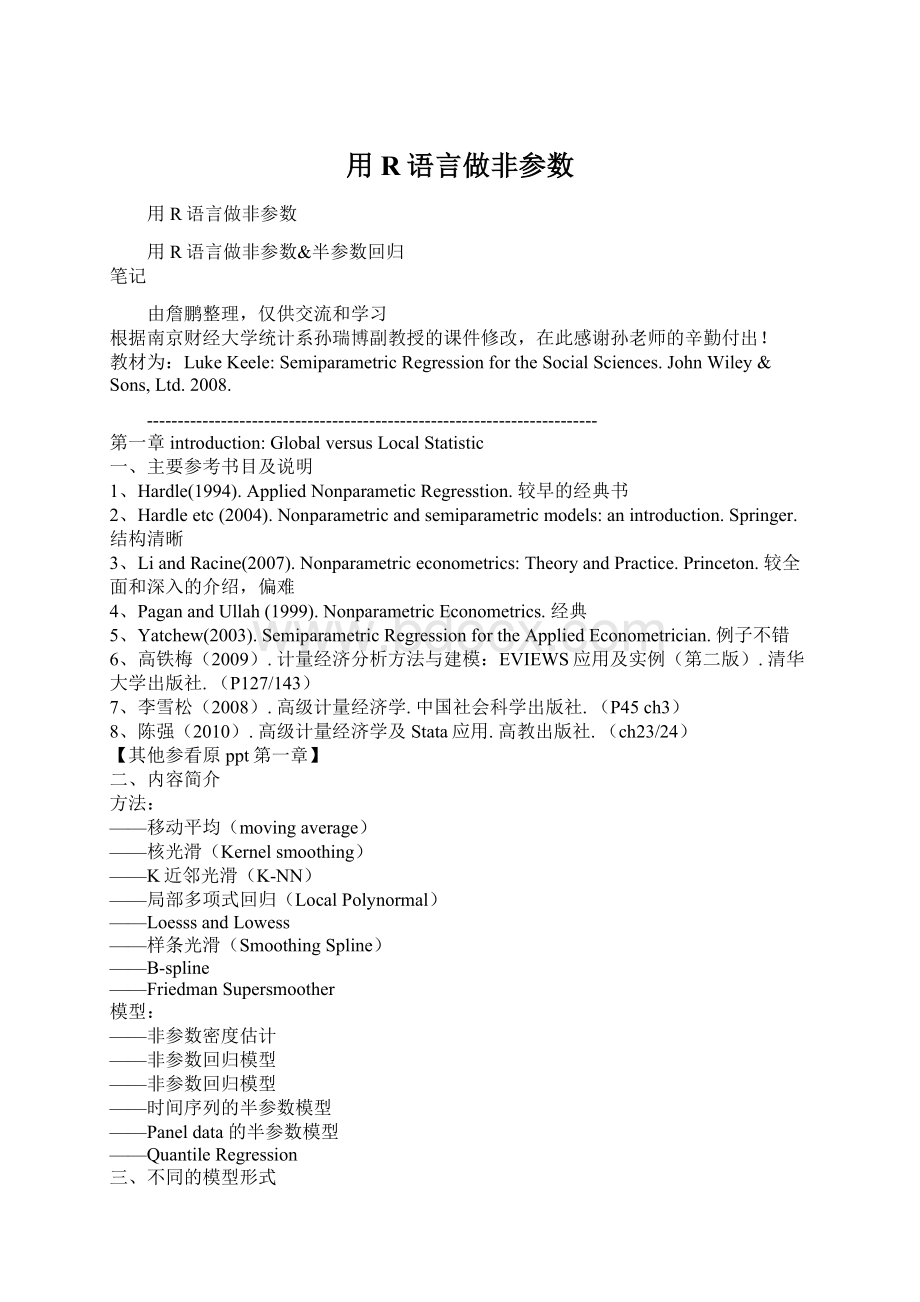用R语言做非参数文档格式.docx
《用R语言做非参数文档格式.docx》由会员分享,可在线阅读,更多相关《用R语言做非参数文档格式.docx(20页珍藏版)》请在冰豆网上搜索。

——FriedmanSupersmoother
模型:
——非参数密度估计
——非参数回归模型
——时间序列的半参数模型
——Paneldata的半参数模型
——QuantileRegression
三、不同的模型形式
1、线性模型linearmodels
2、Nonlinearinvariables
3、Nonlinearinparameters
四、数据转换Powertransformation(对参数方法)
IntheGLMframework,modelsareequallyprone(倾向于)tosomemisspecification(不规范)fromanincorrectfunctionalform.
Itwouldbeprudent(谨慎的)totestthattheeffectofanyindependentvariableofamodeldoesnothaveanonlineareffect.Ifitdoeshaveanonlineareffect,analystsinthesocialscienceusuallyrelyonPowerTransformationstoaddressnonlinearity.
[ADD:
检验方法见SanfordWeisberg.AppliedLinearRegression(ThirdEdition).AJohnWiley&
Sons,Inc.,Publication.(本科的应用回归分析课教材)]
----------------------------------------------------------------------------
第二章NonparametricDensityEstimation
非参数密度估计
一、三种方法
1、直方图Hiatogram
2、Kerneldensityestimate
3、Knearest-neighborsestimate
二、Histogram对直方图的一个数值解释
Supposex1,…xN–f(x),thedensityfunctionf(x)isunknown.
Onecanusethefollowingfunctiontoestimatef(x)
【与x的距离小于h的所有点的个数】
三、Kerneldensityestimate
Bandwidth:
h;
Windowwidth:
2h.
1、Kernelfunction的条件
ThekernelfunctionK(.)isacontinuousfunction,symmetric(对称的)aroundzero,thatintegrates(积分)tounityandsatisfiesadditionalboundedconditions:
(1)K()issymmetricaround0andiscontinuous;
(2)
;
(3)Either
(a)K(z)=0if|z|>
=z0forz0
Or
(b)|z|K(z)à
0as
(4)
where
isaconstant.
2、主要函数形式
3、置信区间
其中,
4、窗宽的选择
实际应用中,
。
其中,s是样本标准差,iqr是样本分位数级差(interquartilerange)
四、Knearest-neighborsestimate
五、R语言部分
da<
-read.table("
PSID.txt"
header=TRUE)
lhwage<
-da$lhwage
#***bandwidth相等,核函数不同***
den1<
-density(lhwage,bw=0.45,kernel="
epan"
)
den2<
gauss"
den3<
biwe"
den4<
rect"
plot(den4,lty=4,main="
"
xlab="
LogHourlyWage"
ylab="
Kerneldensityestimates"
lines(den3,lty=3,col="
red"
lines(den2,lty=2,col="
green"
lines(den1,lty=1,col="
blue"
#***bandwidth不相等,核函数也不同***
den5<
-density(lhwage,bw=0.545,kernel="
den6<
-density(lhwage,bw=0.246,kernel="
den7<
-density(lhwage,bw=0.646,kernel="
den8<
-density(lhwage,bw=0.214,kernel="
plot(den8,lty=4,main="
lines(den7,lty=3,col="
lines(den6,lty=2,col="
lines(den5,lty=1,col="
----------------------------------------------------------------------------
第三章smoothingandlocalregression
一、简单光滑估计法SimpleSmoothing
1、LocalAveraging局部均值
按照x排序,将样本分成若干部分(intervalsor“bins”);
将每部分x对应的y值的均值作为f(x)的估计。
三种不同方法:
(1)相同的宽度(equalwidthbins):
uniformlydistributed.
(2)相同的观察值个数(equalno.ofobservationsbins):
k-nearestneighbor.
(3)移动平均(movingaverage)
K-NN:
等窗宽:
2、kernelsmoothing核光滑
其中,
二、局部多项式估计LocalPolynomialRegression
1、主要结构
局部多项式估计是核光滑的扩展,也是基于局部加权均值构造。
——localconstantregression
——locallinearregression
——lowess(Cleveland,1979)
——loess(Cleveland,1988)
【本部分可参考:
Takezana(2006).IntroductiontoNonparametricRegression.(P1853.7andP1953.9)
ChambersandHastie(1993).StatisticalmodelsinS.(P312ch8)】
2、方法思路
(1)对于每个xi,以该点为中心,按照预定宽度构造一个区间;
(2)在每个结点区域内,采用加权最小二乘法(WLS)估计其参数,并用得到的模型估计该结点对应的x值对应y值,作为y|xi的估计值(只要这一个点的估计值);
(3)估计下一个点xj;
(4)将每个y|xi的估计值连接起来。
【R操作
library(KernSmooth)#函数locpoly()
library(locpol)#locpol();
locCteSmootherC()
library(locfit)#locfit()
#weightfunciton:
kernel=”tcub”.And“rect”,“trwt”,“tria”,“epan”,“bisq”,“gauss”
】
3、每个方法对应的估计形式
(1)变量个数p=0,localconstantregression(kernelsmoothing)
min
(2)变量个数p=1,locallinearregression
(3)Lowess(LocalWeightedscatterplotsmoothing)
p=1:
【还有个加权修正的过程,这里略,详见原书或者PPT】
(4)Loess(Localregression)
p=1,2:
(5)Friedmansupersmoother
symmetrick-NN,usinglocallinearfit,
varyingspan,whichisdeterminedbylocalCV,
notrobusttooutliers,fasttocompute
supsmu()inR
三、模型选择
需要选择的内容:
(1)窗宽thespan;
(2)多项式的度thedegreeofpolynomialforthelocalregressionmodels;
(3)权重函数theweightfunctions。
【其他略】
四、R语言部分
library(foreign)
library(SemiPar)
library(mgcv)
jacob<
jacob.txt"
###############################################################################
#第一部分,简单的光滑估计
#1、KernelDensityEstimation
#IllustrationofKernelConcepts
#DefiningtheWindowWidth
attach(jacob)
x0<
-sort(perotvote)[75]
diffs<
-abs(perotvote-x0)
which.diff<
-sort(diffs)[120]
#ApplyingtheTricubeWeight
#...Tricubefunction
tricube<
-function(z){
ifelse(abs(z)<
1,(1-(abs(z))^3)^3,0)
}
#...
a<
-seq(0,1,by=.1)
tricube(a)
#Figure2.5
plot(range(perotvote),c(0,1),xlab="
PerotVote(%)"
ylab="
TricubeWeight"
type='
n'
bty="
l"
abline(v=c(x0-which.diff,x0+which.diff),lty=2)
abline(v=x0)
xwts<
-seq(x0-which.diff,x0+which.diff,len=250)
lines(xwts,tricube((xwts-x0)/which.diff),lty=1,lwd=1)
points(x.n,tricube((x.n-x0)/which.diff),cex=1)
###########################################################################
#2、KernelSmoothing
Figure2.6
par(mfrow=c(3,1))
plot(perotvote,chal.vote,pch="
."
cex=1.95,
xlab="
Challenger'
sVoteShare(%)"
main="
Bandwidth=4"
lines(ksmooth(perotvote,chal.vote,bandwidth="
4"
))
cex=.65,
Bandwidth=8"
lines(ksmooth(perotvote,chal.vote,kernel="
box"
bandwidth="
8"
),lty=1)
Bandwidth=12"
12"
#*******Kernelsmoothing中选取box和normal核函数的比较,带宽相等
cex=.65,xlab="
main="
),lty=1)
normal"
),lty=2,col="
)
##################################################################################
#第二部分,LPR模型
#DataPrepForLocalAverageRegressionStep-by-Step
cong<
-as.data.frame(jacob[,2:
3])
-cong[order(cong$perotvote),1:
2]
y<
-as.matrix(cong$chal.vote)
x<
-as.matrix(cong$perotvote)
n<
-length(y)
-x[75]
-abs(x-x0)
x.n<
-x[diffs<
=which.diff]
y.n<
-y[diffs<
weigh=tricube((x.n-x0)/which.diff)
mod<
-lm(y.n~x.n,weights=weigh)
#Figure2.7
plot(x,y,type="
n"
abline(v=c(x0-which.diff,x0+which.diff),lty=2)
points(x[diffs>
which.diff],y[diffs>
which.diff],pch=16,cex=1,col=gray(.80))
points(x[diffs<
=which.diff],y[diffs<
=which.diff],cex=.85)
abline(mod,lwd=2,col=1)
text(27.5,50,expression(paste("
FittedValueofyat"
x[0])))#这里expression的用法比较有意思
arrows(25,47,15,37,code=2,length=.10)
#################################################################################
#2、NowPuttingItTogetherForLocalRegressionDemonstration.
#OLSFitforComparison
ols<
-lm(chal.vote~perotvote,data=jacob)
#Theloessfit
model.loess<
-loess(chal.vote~perotvote,data=jacob,span=0.5)
#***默认设置degree=2,family=gauss,tricube加权***
-length(chal.vote)
x.loess<
-seq(min(perotvote),max(perotvote),length=n)
y.loess<
-predict(model.loess,data.frame(perotvote=x.loess))#得到预测值便于比较
#Thelowessfit
model.lowess<
-lowess(chal.vote~perotvote,data=jacob,f=0.5)
#***默认设置robustlineartricube加权***
x.lowess<
y.lowess<
-predict(model.lowess,data.frame(perotvote=x.lowess))#得到预测值便于比较
#Figure2.8
ylab="
Challengers'
VoteShare(%)"
xlab="
VoteforPerot(%)"
lines(x.loess,y.loess)
lines(x.lowess,y.lowess)
abline(ols)
legend(15,20,c("
Loess"
"
Lowess"
"
OLS"
),lty=c(1,2,1),bty="
cex=.8)
#3、lowess中不同robust的比较
m1.lowess<
-lowess(perotvote,chal.vote,f=0.5,iter=0)
#***没有进行第二步的robust加权估计***
m2.lowess<
-lowess(perotvote,chal.vote,f=0.5)
#***默认iter=3,要进行3次robust加权估计***
m0.loess<
-loess(chal.vote~perotvote,data=jacob,
span=0.5,degree=1,family="
symm"
iter